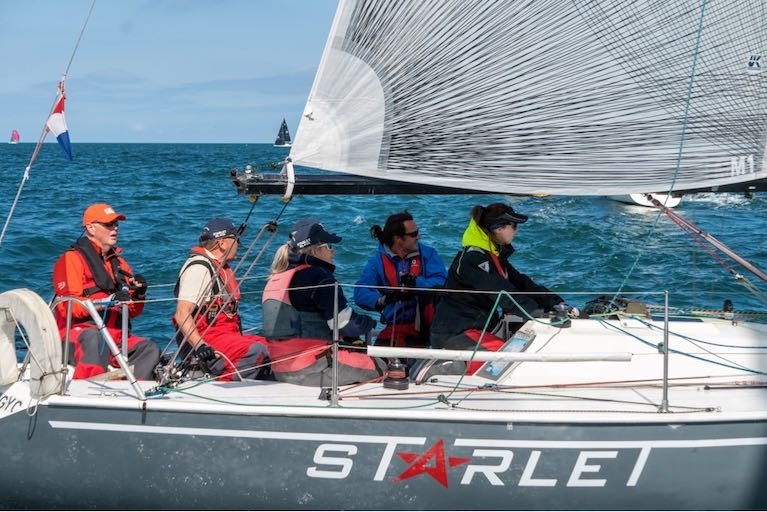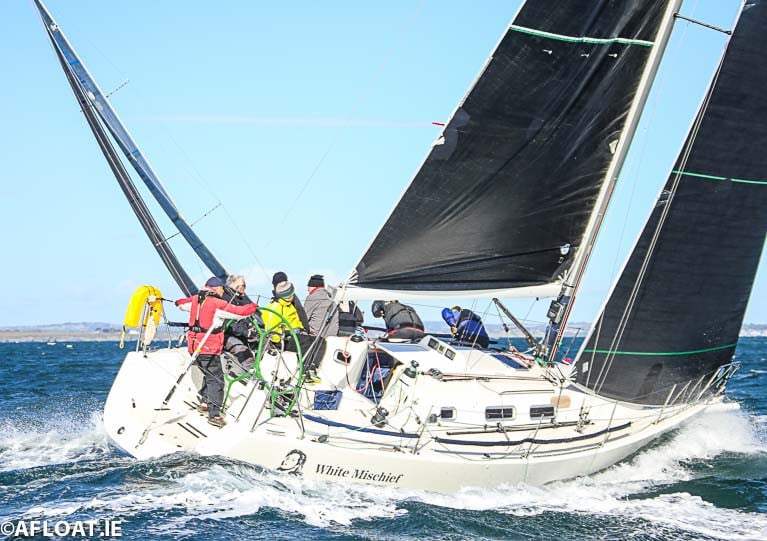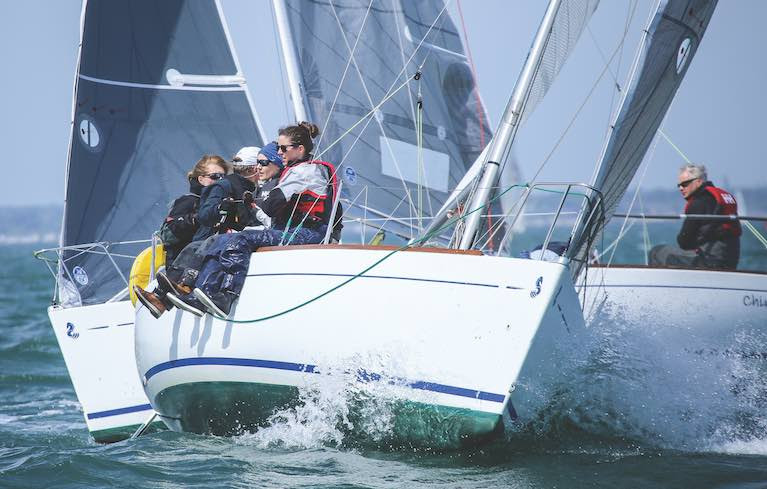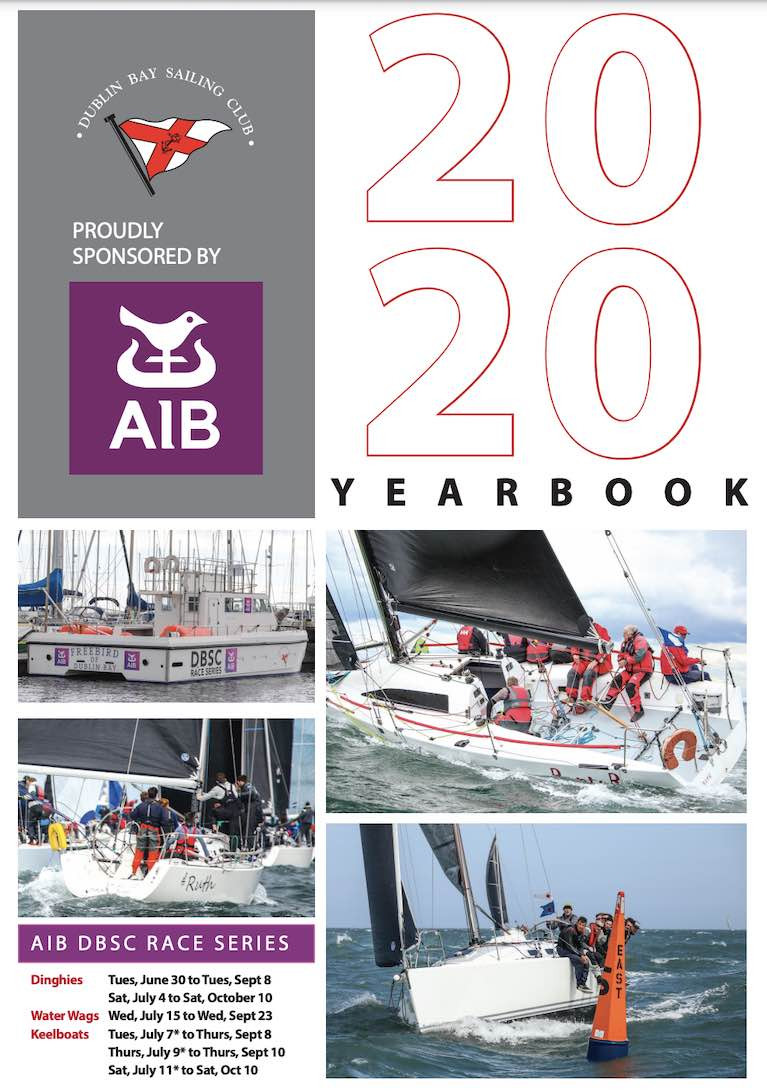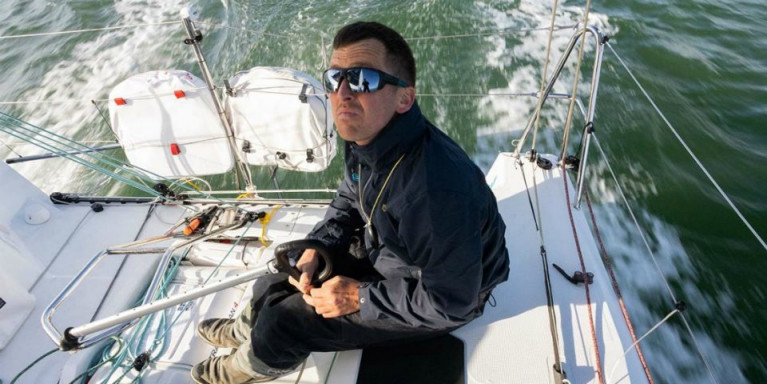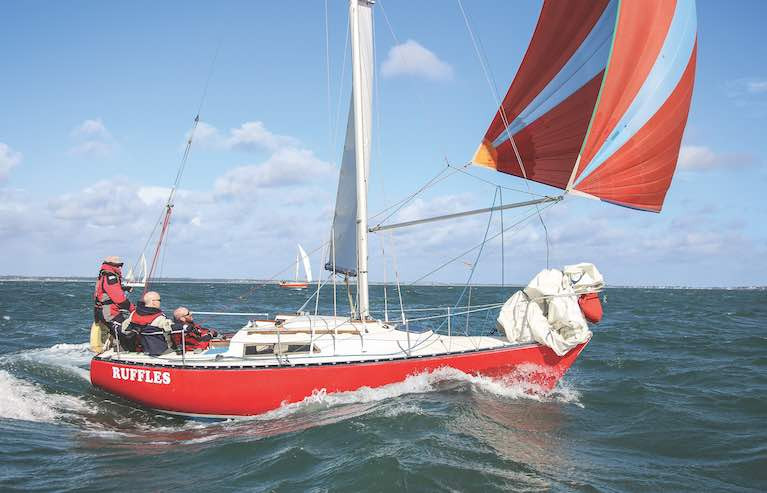Displaying items by tag: Dublin Bay Sailing Club
Royal St. George Yacht Club Celebrate DBSC Cruiser, One Design & Dinghy Victories
Lindsay Casey's Royal St. George Yacht Club J97 Windjammer that has performed on both inshore and offshore circuits this season was the winner of the best yacht on handicap and has lifted Dublin Bay Sailing Club's premier Waterhouse Shield award.
The overall results were announced recently by DBSC but unfortunately without the usual end of season prizegiving.
In Cruisers Two division, the premier award winner also won both the Lady Shamrock Trophy for Thursdays IRC racing and the Silver Salver for Saturdays IRC competition. On top of these inshore results, the Royal St. George J-boat also competing in some of this season's ISORA coastal races from Dun Laoghaire Harbour. There were other Royal St. George Yacht Club victories in Class Two too. Among them was Dick Lovegrove's Sigma 33 Rupert that won the JB Stephens Trophy for the combined Thursday and Saturday performance.
 Royal St. George J97 Windjammer
Royal St. George J97 Windjammer
In the Cruisers Three division, Kevin Byrne's Starlet (pictured top) was the winner of Tuesday's Thursdays and Saturday's IRC picking up the Whimbrel Rose Bowl, Smalldridge Cup and Jack Kennedy Memorial Cup respectively.
In Cruisers Five, the Gerry Henry Salver for Thursdays ECHO Overall Div A went to Thomas Dunne's Katienua.
In the Mixed Sportsboats, a cut-glass tumbler went to Jonathan Craig for his Tuesday performance in the J80 'George 5'.
Royal St. George One Designs
In the SB20s Michael O'Connor, Davy Taylor and Ed Cook celebrated their double win of The Crichton Cup for Thursday Racing and the
SB Cup for Saturday racing.
Royal St. George Dinghies
In the PY dinghy class, Brendan Foley's RS Aero Minty was the Early Bird Trophy Saturdays overall winner.
In the Lasers, Sanderling Trophy for Saturdays Overall in the Standard division went to Finn Walker.
And in the Radial division, Sean Craig won the Jimmy Mooney Trophy for Tuesday and Saturday racing combined plus a cut-glass tumbler for Tuesday racing overall.
See the full DBSC prizewinners list here.
Royal Irish Yachts Share the Spoils of Dublin Bay Sailing Club Season
The Royal Irish Yacht Club (RIYC) took the lion’s share of IRC prizes at the recent Dublin Bay Sailing Club (DBSC) prizegiving for the 2020 AIB sponsored season with wins in Cruisers Zero, One divisions and two of the club's premier awards.
DBSC broke with long-established tradition this year due to COVID-19 and its popular and long-established prizegiving for 300 boats in 22 different classes was not held, but that did not stop the award of the usual glittering array of trophies as Afloat reported here.
On top of the DBSC premier award of the Dun Laoghaire Harbour Trophy for the best new yacht in 2020 won by the club's Prima Forte (Patrick Burke) there were RIYC class wins for the JPK10.80 Rockabill VI (Paul O'Higgins) who won the Martin Cup for Thursday IRC racing in IRC Zero big boat class. The Club's XP44 Wow (George Sisk) won the ECHO trophy for Saturday racing in this class and Burke's Prima Forte took the Centenary Cup for Saturday ECHO racing.
 DBSC Dun Laoghaire Harbour Trophy winner, Prima Forte
DBSC Dun Laoghaire Harbour Trophy winner, Prima Forte
The Royal Irish J109 father and son team of Tim and Richard Goodbody were Thursday IRC winners in Cruisers One, winning the West Pier Officer's Cup for Thursday racing and in Saturday ECHO racing, Paul Bradley and Fintan Cairns lifted the Osterburg Cup sailing the Mills 31 Raptor.
In Class Two, Jim McCann's Peridot, was Thursday's champion on ECHO winning the Centenary Cup and in another ECHO victory for the club, Paget McCormack's Saki won the Cruisers Three Mercia Cup for Thursday racing.
In Class Five, Charles Broadhead's Persistence was the winner of the Burford Trophy for his win in Thursdays IRC Overall Div A while Grainne O'Shea's Gung-Ho was the victor in Sats A and B IRC Overall winning the White Sail Class Trophy.
 DBSC Osterburg Cup winner, Raptor
DBSC Osterburg Cup winner, Raptor
RIYC One Designs & Dinghies
It didn't stop there for the RIYC fleet as there were some top results in the one-design divisions too. As Afloat reported previously, Jimmy Conboy Fischer sailing Billy Whizz was awarded the club's Geroge Arthur Newsom Trophy for the best result in the one-design divisions. It was the first time the top prize had been awarded to the B211s.
In the SB20s, the Lunasa Trophy for Saturday Div B was won by the club's Ger Dempsey and Chris Nolan sailing Venuesworld. Dragon racing victory on Thursday's went to Zin Zan, skippered by Adrian Masterson. In the Mixed Sports boats class, the Saturday Sportsboat Cup went to Martin Ryan's J80, Jambiya.
In the dinghy classes, Guy Kilroy's Swift was the Goldsmith Cup winner for Wednesday Racing in the Water Wag class.
Full DBSC winners here.
Beneteau 211s Win Premier Dublin Bay Sailing Club One Design Trophy for the First Time
Dun Laoghaire's Beneteau 211 class has won Dublin Bay Sailing Club's (DBSC) Premier George Arthur Newsom Cup for the first time.
The Cup is awarded to the boat which performs best compared to all One Design classes in Dublin Bay.
It was a clean sweep for Jimmy Fischer on his boat Billy Whizz, with two different crews taking the following trophy haul that, regrettably, the club did not get the chance to present as the annual prize-giving had to be deferred due to the Covid-19 restrictions.
- The George Arthur Newsom Cup - for the most successful boat in one-design racing
- The Facet Jewellers Cup - for Thursdays scratch overall
- The Beneteau 21 Tray - for Thursdays ECHO overall
- The Beneteau Cup - for Saturdays scratch overall
The feat was achieved by Jimmy with two different crews, one on Thursdays comprising Joe Smyth, Annette Ni Murchu and her brother Brian Murphy. Not only did they win Thursdays on scratch, but they managed the rare feat of winning Thursdays on ECHO also. Joe, Annette and Brian are all longterm members of Blessington Sailing Club.
Sailing with Jimmy on Saturdays, Peter Duggan and Les Richards won the series on scratch. Peter is another graduate of Blessington Sailing Club and has foredeck experience on J109 Jalapeño, with Paul Barrington et al. Les is a partner in a Trapper 501 in Bray Sailing club..
Jimmy says Afloat magazine's David O'Brien is the direct reason why he joined the B21s when he came back into sailing after a twenty-year absence while Catherine and Jimmy raised their two daughters. David and Jimmy know each other from way back in their IDRA 14 sailing days.
When Jimmy suggested he might take up sailing again, David recommended the B21s as he knows Jimmy's first love has always been one-design sailing. He also suggested there was good camaraderie and a helpful bunch in the class.
Jimmy crewed with current RIYC Commodore Pat Shannon in 2017 and bought Pat's boat, Billy Whizz, at the end of that season.
Seasons 2018 and 2019 were spent getting back in the groove, leading to success in 2020. Jimmy commented that the North Sails mainsail and jib that Prof O'Connell supplied proved to be both powerful and fast, adding to Billy Whizz's results on the water.
Watch this fleet, the B21s are growing fast and there's great fun and competition throughout the fleet.
Read more on the Beneteau 211 here
Dublin Bay Sailing Club Launch AIB Sponsorship With Stories of Resilience from Irish Professional Sailors
Dublin Bay Sailing Club (DBSC) will hold a virtual event next Thursday, 12th November 2020 at 19.30hrs to welcome its exciting new sponsorship with AIB Private Banking.
As Afloat previously reported, Ireland's largest yacht racing club is hosting the live panel discussion on “Stories of resilience from Irish Professional sailors…on and off the water”
DBSC's Gerry Jones told Afloat he chose the topics for the online event 'as it's a really interesting one & particularly relevant now in these COVID times'.
Fergal Keane of RTE’s Seascapes radio show will chat with four of Ireland’s top professional sailors.
Sports psychology has traditionally been viewed as only having application to high performance or professional sports. However, many of the techniques in sport psychology have just as much relevance for recreational athletes and can be applied to our personal and professional lives. We will hear from these professional sailors about their approach to sports psychology and how resilience forms an essential part of this.
Jones says 'This will be an exciting event, to hear how participants use sports psychology techniques and resilience in shaping their professional and personal lives'.
The contributors are:
Annalise Murphy Olympic Silver Medalist
 Annalise Murphy is nominated in the Laser Radial to compete at the Tokyo Olympics in 2021
Annalise Murphy is nominated in the Laser Radial to compete at the Tokyo Olympics in 2021
Annalise Murphy competed at the 2012 Summer Olympics in the Women’s Laser Radial class, she finished in 4th, her personal best at a world-class regatta.
Annalise won her first major medal at an international event when she won gold at the 2013 European Sailing Championship. On 16 August 2016, she went on to win the silver medal in the Laser Radial at the 2016 Summer Olympics In December 2016, she was honoured as the Irish Times/Sport Ireland 2016 Sportswoman of the Year and the 2016 Afloat Sailor of the Year.
Annalise was a crew member on ‘Turn the Tide on Plastic’ in the 2017/2018 Volvo Ocean Race and is the only Irish sailor nominated so far for the Tokyo 2021 Olympic Regatta.
Damian Foxall, six-time Volvo Ocean veteran
 County Kerry's Damian Foxall has competed in ten round-the-world races
County Kerry's Damian Foxall has competed in ten round-the-world races
Damian Foxall has competed in ten round-the-world races including four wins.
In 2008, he won the Double-handed non-stop round-the-world Barcelona World Race, with Jean Pierre Dick on Virbac
He has competed in 6 Volvo Ocean races with a win in 2011 with Team Groupama and an outright Round the World Record circumnavigation in 2004 with Steve Fossett.
In 1997 Damian became the first non-French entry to win the rookie class in the Single-handed offshore race – La Solitaire du Figaro, he went on to confirm his success in 1998-1999 with a leg win, before changing to the ORMA 60` Trimaran class.
Over the last ten years, Damian has been focusing on the implementation of sustainability within our sport and is currently Sustainability program manager for the 11th Hour Racing team entered in The Ocean Race.
Tom Dolan, Figaro Solo Sailor
 Tom Dolan (right) is preparing to compete in the 2024 Olympics Games where double-handed offshore sailing will make its debut
Tom Dolan (right) is preparing to compete in the 2024 Olympics Games where double-handed offshore sailing will make its debut
Tom Dolan is a professional sailor, based in France, who competes in the Figaro Class.
He has competed in 3 Solitaire Du Figaro on his boat “Smurfit Kappa”. The Solitaire du Figaro lasts just over three weeks and is made up of four races totalling 1800 miles: it is considered to be the most competitive offshore race in the world. The boats are all identical meaning the skipper makes the difference.
Tom finished in 5th place in 2020 and only four places behind Armel Le Cleac’h who was the winner of the 2016/2017 Vendée Globe. Tom is preparing to compete in the 2024 Olympics games where double handed offshore sailing will be a medal event for the first time.
Dr. Kate Kirby, Sports Psychologist
 Dr Kate Kirby is the lead psychologist of the Irish Olympic team for Tokyo 2021
Dr Kate Kirby is the lead psychologist of the Irish Olympic team for Tokyo 2021
Dr. Kate Kirby has worked in high-performance sport for over 15 years and has been the consultant sport psychologist to multiple Olympic, World, and European medallists. She attended the London 2012 and Rio 2016 Games as a member of Annalise Murphy’s support team. In 2019 she was appointed as the lead psychologist of the Irish Olympic team for Tokyo 2020.
Attendees can join using any device, questions and comments during the live talk are welcome and will be answered by the participants at the end.
This is a free public event but you need to join here
Suggestion DBSC Flying Fifteens Continue with 'COVID' Windward Leeward Courses in 2021
Dublin Bay Sailing Club is already starting to plan its racing for the 2021 summer season next week and it's racing sub-committee is taking on board suggestions from the 22 different classes it provides racing for every Tuesday, Wednesday, Thursday and Saturday off Dun Laoghaire Harbour.
There have been many plaudits for how the umbrella racing organisation for all Dun Laoghaire's Yacht Clubs handled the massive changes in pandemic and, as it transpires, some of those changes appear to have taken root for 2021.
The Flying Fifteens, the club's biggest one-design class with a 20-boat fleet, has been asked to canvass members to carry forward the 2020 practice of setting courses over windward/leeward instead of traditional club courses.
"These were most enjoyable, simple to "navigate" and great fun", one senior FFer told Afloat.
"The old practice of struggling with course cards, bearings and damp writing materials, whilst at the same time attempting to steer clear of other boats in gusting breezes and choppy conditions are not routines I would look forward to next year having enjoyed the simplicity of this year's format", he added.
It remains to be seen, however, what transpires for DBSC 2021.
Laser dinghy class praise
DBSC's popular single-handed Laser dinghy class have also been quick to praise the club for how it handled this year's curtailed season and recently made a presentation to its DBSC race officer.
Top Sailors Talk Psychology to Launch AIB DBSC Sponsorship
Dublin Bay Sailing Club (DBSC) will launch its AIB sponsorship with a sailing psychology evening featuring some of the country's top sailors online.
RTÉ's Fergal Keane from Seascapes will host a live chat with top professional sailors Tom Dolan, Annalise Murphy and Damian Foxall as well as leading sports psychologist, Dr Kate Kirby.
 Annalise Murphy training in her Laser dinghy in Dun Laoghaire Harbour Photo: Afloat
Annalise Murphy training in her Laser dinghy in Dun Laoghaire Harbour Photo: Afloat
The sailors will outline their own approaches to sport psychology and how resilience forms an essential part of their make-up.
Sports psychology has traditionally been viewed as only having application to high performance or professional sports. However, many of the techniques in sport psychology have just as much relevance for recreational athletes and also can be applied to our personal and professional lives.
The free DBSC virtual event to highlight its partnership with AIB is on Thursday 12 November at 19.30hrs.
DBSC Turkey Shoot Winter Race Series Notice of Race is Published
The Notice of Race has been published for November's eight-race DBSC Turkey Shoot that is sponsored by the club's new title sponsor, AIB.
Running each Sunday from the 1st November to 20th December and hosted by the Royal Irish Yacht Club, 2020 is the 20th edition of the popular Winter Sailing series in the capital
The short, sharp format of racing has earned a strong following on the capital's waters under race organiser Fintan Cairns and the series regularly attracts up to 60 or 70 boats.
As Afloat reported previously, racing is under modified ECHO. Cruisers, cruising boats, one-designs and boats that do not normally race are very welcome, especially those who may be seeking some more racing given this cut-short COVID-19 hit 2020 season.
In 2019, the 66-boat Dublin Bay-based series was won by the Trapper Eleint with 1720 sportsboats taking second and third overall.
The Notice of Race for the Series is downloadable below.
Continuing Level 3 Restrictions Force End of DBSC Summer Series 2020
There will be no further Dublin Bay Sailing Club Summer Series racing due to the continuing Government Level 3 restrictions and Irish Sailing guidelines.
At the start of the partial lockdown in the capital, it had been hoped that Dublin might emerge from Level 3 conditions at midnight this Friday to enable the final race of the summer to be sailed this Saturday (October 10) on Dublin Bay as per 2020's revised AIB sponsored race schedule.
Unfortunately, however, the continuing restrictions have led DBSC to announce 'there will be no further racing in the above race series', according to DBSC honorary secretary Chris Moore.
DBSC Turkey Shoot
Ireland's largest racing yacht club, is, however, looking forward to its annual Turkey Shoot Series with the first race scheduled for this November 1st, as Afloat previously reported here.
A Notice of Race and online entry forms will be available in the near future.
Dublin Bay Sailing Club 'Suspends' Racing With Immediate Effect Over Covid Level 3 Restrictions
Dublin Bay Sailing Club has 'suspended' its AIB DBSC 2020 Summer Sailing Series in light of this evening's latest government Level 3 restrictions that impact sailing activity.
As the Level 3 partial shutdown is expected to extend beyond the last race of the DBSC season in October it effectively ends the 2020 summer racing season for the largest yacht racing club in the country.
Dublin Bay Sailing Club is the umbrella organisation for all four waterfront clubs in Dun Laoghaire Harbour and this year had seen regular turnouts of over 100 boats for Thursday and Saturday racing.
As Afloat reported earlier, the suspension follows the earlier cancellation of the Laser Masters Championships at the Royal St. George Yacht Club also at Dun Laoghaire.
DBSC's Honorary Secretary, Chris Moore says "We take the opportunity of thanking all our members and volunteers for their input during 2020, and look forward to more normal times in the future. Stay Safe, and respect social distancing".
Great Turnout for Saturday's DBSC Racing on Dublin Bay
132 boats across 20 classes turned out for Saturday's Dublin Bay Sailing Club Race.
In the big cruiser division, the First 40 Prima Forte was the IRC Zero winner from XP 44 WOW and the Beneteau 44.7 Lively Lady.
IRC One was dominated by J109s. White Mischief won from Chimaera and Something Else.
In the One Design classes, many of which had two races, Frequent Flyer was the winner of both Flying Fifteen races. Likewise in the SB20s where Ted won two from two.
Full results below
DBSC Results for 12/09/2020
Race 1
Cruiser 0 IRC: 1. Prima Forte, 2. Wow, 3. Lively Lady
Cruiser 0 Echo: 1. Prima Forte, 2. Lively Lady, 3. D-Tox
Cruiser 1 IRC: 1. White Mischief, 2. Chimaera, 3. Something Else
Cruiser 1 Echo: 1. Something Else, 2. White Mischief, 3. Jump the Gun
Cruiser 1 J109: 1. White Mischief, 2. Chimaera, 3. Ruth
31.7 One Design: 1. Levante, 2. Prospect, 3. Bluefin Two
31.7 Echo: 1. Fiddly Bits, 2. Bluefin Two, 3. Levante
Cruiser 2 IRC: 1. Windjammer, 2. Peridot, 3. Rupert
Cruiser 2 Echo: 1. Boojum, 2. Enchantress, 3. Leeuwin
Cruiser 2 Sigma 33: 1. Rupert, 2. Leeuwin, 3. Boojum
Cruiser 3 IRC: 1. Starlet, 2. Dubious, 3. Maranda
Cruiser 3 Echo: 1. Pamafe, 2. Krypton, 3. Starlet
Cruiser 5 NS-IRC: 1. Gung Ho, 2. Persistance, 3. Act Two
Cruiser 5 Echo: 1. Act Two, 2. Sweet Martini, 3. Sea Safari
SB20: 1. Ted, 2. Carpe Diem, 3. SeaBiscuit
Sportsboat: 1. George/Riordan/Simington, 2. Jambiya, 3. George 1/McNamara
Dragon: 1. Phantom, 2. D-Cision
Flying 15: 1. Frequent Flyer, 2. Ignis Caput, 3. Flyer
Ruffian: 1. Bandit, 2. Ripples, 3. Ruffles
Shipman: 1. Poppy, 2. Jo Slim, 3. Invader
B211 One Design: 1. Ventuno, 2. Small Wonder, 3. Beeswing
B211 Echo: 1. Ventuno, 2. Small Wonder, 3. Plan B
Glen: 1. Glen Luce, 2. GlenDun, 3. Glenroan
PY Class: 1. N Butler, 2. B Foley, 3. Allsorts
IDRA 14: 1. Slipstream, 2. Dart, 3. Chaos
Fireball: 1. F Miller, 2. P ter Horst, 3. N Miller
Laser Standard: 1. F Walker, 2. R O'Leary, 3. B Maguire
Laser Radial: 1. G Fisher, 2. C Gorman, 3. R Geraghty-McDonnell
Laser 4.7: 1. A Daly, 2. L Turvey, 3. F McDonnell
Race 2
SB20: 1. Ted, 2. venuesworld.com, 3. Carpe Diem
Sportsboat: 1. Jambiya, 2. George 1/McNamara, 3. G. O'Connor
Dragon: 1. Phantom, 2. D-Cision
Flying 15: 1. Frequent Flyer, 2. FFuZZy, 3. Phoenix
B211 One Design: 1. Billy Whizz, 2. Chinook, 3. Beeswing
B211 Echo: 1. Ventuno, 2. Small Wonder, 3. Beeswing
PY Class: 1. N Butler, 2. Allsorts, 3. B Foley
IDRA 14: 1. Chaos, 2. Dutch Courage, 3. Slipstream
Fireball: 1. F Miller, 2. N Miller, 3. P ter Horst
Laser Standard: 1. G Murphy, 2. R O'Leary, 3. F Walker
Laser Radial: 1. J Murphy, 2. R Geraghty-McDonnell, 3. C Gorman
Laser 4.7: 1. L Turvey, 2. A Daly, 3. H Turvey




























